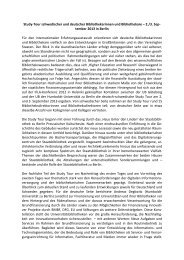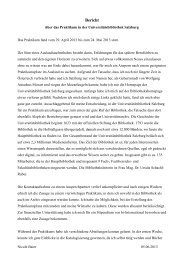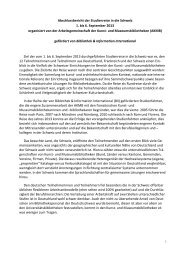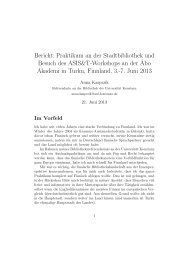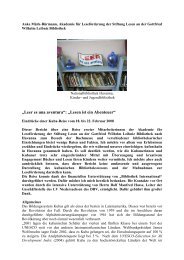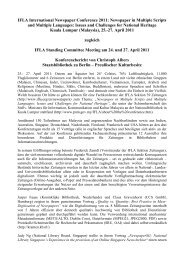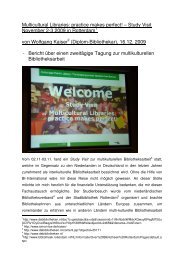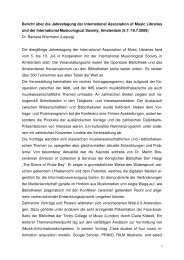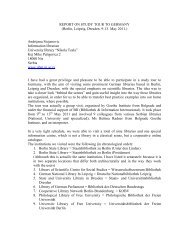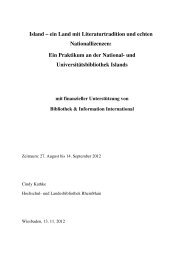art collections in germany - Bibliothek & Information International
art collections in germany - Bibliothek & Information International
art collections in germany - Bibliothek & Information International
Create successful ePaper yourself
Turn your PDF publications into a flip-book with our unique Google optimized e-Paper software.
Art Collections <strong>in</strong> Germany<br />
A Study Tour for North American Librarians at the <strong>in</strong>vitation of the<br />
Goethe-Instituts <strong>in</strong> North America<br />
In September, 2008 the Goethe-Instituts <strong>in</strong> North America <strong>in</strong>vited a group of lead<strong>in</strong>g<br />
<strong>art</strong> librarians from North America to Germany for a study tour to explore some of<br />
Germany’s top libraries with significant <strong>art</strong> <strong>collections</strong>. Institutions <strong>in</strong> Munich, Weimar<br />
and Berl<strong>in</strong> were chosen to receive the North American guests. Throughout the trip<br />
the North American delegation was offered a beh<strong>in</strong>d-the-scenes look at some of<br />
Germany’s lead<strong>in</strong>g digitization and preservation projects, along with an extensive<br />
overview of the <strong>art</strong> <strong>collections</strong> at each <strong>in</strong>stitution.<br />
The follow<strong>in</strong>g, are two reports from two of the study tour p<strong>art</strong>icipants outl<strong>in</strong><strong>in</strong>g their<br />
impressions from the study tour. A complete overview of the it<strong>in</strong>erary and p<strong>art</strong>icipants<br />
can be found at the end of the report.<br />
Dr. Susan M. Allen<br />
Associate Director<br />
Chief Librarian, Research Library<br />
The Getty Research Institute<br />
1200 Getty Center Dr., Suite 1100<br />
Los Angeles, CA 90040<br />
Sallen@getty.edu<br />
Prefatory remarks:<br />
I would like to he<strong>art</strong>ily thank the Goethe-Instituts <strong>in</strong> North America, and its very<br />
able representative, Shawn Whatley, for <strong>in</strong>vit<strong>in</strong>g me on this study tour. It was<br />
revelatory for me as I had never before visited all but one of the libraries on the tour.<br />
My notes below record what I heard and observed at each location. What they do<br />
not record systematically is the various <strong>in</strong>sights and “aha moments” I experienced<br />
dur<strong>in</strong>g the trip and s<strong>in</strong>ce my return. The trip was <strong>in</strong>valuable. Furthermore, my fellow<br />
librarian travel<strong>in</strong>g companions were the best colleagues one could ever have, and all<br />
of our creature comforts were provided for to perfection. Aga<strong>in</strong>, thank you. SMA<br />
Day 1 (a.m.): <strong>Bibliothek</strong> des Zentral<strong>in</strong>stituts für Kunstgeschichte (ZIKG)<br />
Very productive meet<strong>in</strong>gs were held with Prof. Dr. Wolf Tegethoff, Director of<br />
the ZIKG; Dr. Rüdiger Hoyer; Library Director; and Dr. Carola Wenzel, Associate<br />
Library Director. I was most <strong>in</strong>terested <strong>in</strong> ga<strong>in</strong><strong>in</strong>g <strong>in</strong>formation on the topics below.<br />
Facilities:<br />
The tour of the library focused on facilities needs: growth space for <strong>collections</strong>,<br />
conference and class room space, and office space for scholars.<br />
Organization:
There are 50 <strong>in</strong>stitute employees. There are 26 employees (38 <strong>in</strong>clud<strong>in</strong>g<br />
student assistants) more or less to staff the library. Therefore, the library is too small<br />
for dep<strong>art</strong>ments and every employee has more than one specialty. For example,<br />
catalogers also act as reference librarians. It is a very flat organizational structure.<br />
The ZIKG is greatly restricted <strong>in</strong> what it may or may not do with human resources<br />
because it is a German governmental <strong>in</strong>stitution. The ZIKG depends on student<br />
employees to provide modern library services. The student employees normally work<br />
10-20 hours per week.<br />
There is no separate IT dep<strong>art</strong>ment. Some IT work is done <strong>in</strong>-house and<br />
some is out-sourced. An External specialist does all the programm<strong>in</strong>g. ZIKG<br />
depends on the State of Bavaria for the <strong>in</strong>frastructure.<br />
Acquisitions:<br />
Acquire 10,000 titles per year, and of these, 100 items may be of an<br />
antiquarian nature. The British book market is almost <strong>in</strong>accessible due to the high<br />
prices. Acquisition of material document<strong>in</strong>g contemporary <strong>art</strong> is grow<strong>in</strong>g on an<br />
<strong>in</strong>ternational level. Dr. Hoyer and Dr. Wenzel make the selections. Visit<strong>in</strong>g scholars<br />
have some impact on acquisitions. For example, at the moment two Kress Fellows <strong>in</strong><br />
residence are work<strong>in</strong>g on German topics.<br />
A “New Acquisitions List” for the ZIKG can be found on the website – <strong>in</strong><br />
German – “Neuerwerbungsliste.” The ZIKG relies on specialized book dealers for<br />
acquisitions. Dr. Hoyer travels and visits booksellers elsewhere <strong>in</strong> Europe, especially<br />
Paris. Venders employed <strong>in</strong>clude Erasmus <strong>in</strong> Paris and a bookseller <strong>in</strong> Moscow who<br />
deals on the Internet and sends a list to the library every week. The ZIKG cont<strong>in</strong>ues<br />
to have an exchange program, but it is not efficient. Dr. Hoyer will provide a list of<br />
vendors. (I need to follow up on this.)<br />
Question of “European Art” – the ZIKG cannot expand <strong>in</strong>to “world <strong>art</strong>” but<br />
would like to develop <strong>collections</strong> <strong>in</strong> a more limited way toward Turkey and the Islamic<br />
world <strong>in</strong> p<strong>art</strong>icular. To do this, it would need language expertise, and staff would<br />
need to learn the book markets for this p<strong>art</strong> of the world. It was also seen as a<br />
political question as well.<br />
Staff Development:<br />
There is no formal <strong>in</strong>ternal tra<strong>in</strong><strong>in</strong>g; however, external programs are available<br />
through the Bavaria State Library and the Bavaria Library School.<br />
Day 1 (p.m.): Bayerische Staatsbibliothek<br />
At the Bavarian State Library we were greeted by officials and presented with<br />
a sophisticated PowerPo<strong>in</strong>t overview of the <strong>in</strong>stitution’s “Three Pillar Profile.” In the<br />
past the library has been a treasure house of cultural heritage, currently it is a multimedia<br />
<strong>in</strong>formation provider, and <strong>in</strong> the future it will be a center of <strong>in</strong>novation.<br />
It considers peer <strong>in</strong>stitutions to be all those who see a future for libraries: The<br />
British Library, Stanford University Library, the University of Michigan Libraries, the<br />
National Library of S<strong>in</strong>gapore, and the State Library of Berl<strong>in</strong>.<br />
Of all readers, 68% are students. Between 2002 and 2007 use <strong>in</strong>creased<br />
107%. A big jump occurred <strong>in</strong> 2006 when the hours of the library were extended. In<br />
the past the library sought to get rid of students; now it wants to attract them. To do<br />
this the hours were extended; the library opens at 8 a.m. and rema<strong>in</strong>s open until<br />
midnight. (I was p<strong>art</strong>icularly <strong>in</strong>terested <strong>in</strong> a self-service reserve read<strong>in</strong>gs area that<br />
could be used as a model for the Research Library at the Getty Villa.) It is a library of
last resort for university libraries <strong>in</strong> Germany. The ma<strong>in</strong> build<strong>in</strong>g houses 43% of the<br />
library’s <strong>collections</strong> while 57% are on off-site storage.<br />
Digitization Strategy:<br />
The Bavarian State Library sees as it audience all researchers worldwide.<br />
Therefore, its goal is to digitize the complete hold<strong>in</strong>gs <strong>in</strong> the next 20 years. There<br />
have been sixty boutique digitization projects s<strong>in</strong>ce 1997. Now, us<strong>in</strong>g equipment<br />
know as the ScanRobot, the library has begun mass digitization. The equipment was<br />
demonstrated for us. It uses a cradle to support the book be<strong>in</strong>g scanned, two digital<br />
cameras both pages of an open<strong>in</strong>g <strong>in</strong> a book, and puffs of air to turn the pages.<br />
Conservators have determ<strong>in</strong>ed that it is safe for rare books, and, <strong>in</strong> fact, we saw<br />
some be<strong>in</strong>g scanned.<br />
The f<strong>in</strong>ancial strategy to accomplish digitization is to seek third p<strong>art</strong>y fund<strong>in</strong>g<br />
for digitization of medieval manuscripts, <strong>in</strong>cunables, and 16 th C books; and to allow<br />
Google to digitize one million 17 th C – 19 th C books.<br />
The library downloads its metadata to WorldCat and has established a<br />
presence on Second Life.<br />
Day 2: Herzog<strong>in</strong> Anna Amalia <strong>Bibliothek</strong><br />
Of all the libraries we visited on the tour, the Herzog<strong>in</strong> Anna Amalia <strong>Bibliothek</strong><br />
<strong>in</strong> Weimar was the most awe <strong>in</strong>spir<strong>in</strong>g. This library, a public circulat<strong>in</strong>g library s<strong>in</strong>ce<br />
the 18 th C, was devastated by a fire <strong>in</strong> September 2004. S<strong>in</strong>ce then, phoenix-like,<br />
the historic build<strong>in</strong>g has been rebuilt, fire and water-damaged books have been<br />
salvaged and conserved, and 70% of the rare books that were completely destroyed<br />
by the fire have now been replaced.<br />
Dr. Michael Knoche, the director, was our tour guide, and his tour focused<br />
primarily on facilities. We were able to have a close look at the new build<strong>in</strong>g that had<br />
been <strong>in</strong>serted <strong>in</strong> a courtyard <strong>in</strong> the center of the orig<strong>in</strong>al facility, and we visited the<br />
underground state of the <strong>art</strong> storage vaults that connect, by go<strong>in</strong>g under a roadway,<br />
the new p<strong>art</strong> with the orig<strong>in</strong>al facility. The book tower of the orig<strong>in</strong>al facility suffered<br />
the fire damage, and we were able to see that it has been completely restored.<br />
I was p<strong>art</strong>icularly <strong>in</strong>terested <strong>in</strong> the public nature of the library go<strong>in</strong>g back to the<br />
18 th C. A log book of library circulation from the 18 th C shows that from 30 to 40<br />
women checked out books from the library on a regular basis. Who these women<br />
were rema<strong>in</strong>s to be <strong>in</strong>vestigated.<br />
Day 3: Staatsbibliothek zu Berl<strong>in</strong><br />
We were greeted at the Berl<strong>in</strong> State Library and given an <strong>in</strong>troduction to it by<br />
the Director General, Barbara Schneider-Kempf, Dr. Jutta Weber, head of the<br />
Manuscript Dep<strong>art</strong>ment, and Gerd-Josef Bötte, deputy director of the Dep<strong>art</strong>ment of<br />
Early Pr<strong>in</strong>ted Books. Due to the division of Berl<strong>in</strong> follow<strong>in</strong>g World War II and<br />
reunification <strong>in</strong> 1992, the library is on two sites. Its budget is 50 million Euros and<br />
<strong>collections</strong> amount to 10 million books. The site we visited houses manuscripts and<br />
rare books while the second site functions more like a public library. We also learned<br />
that dur<strong>in</strong>g the Second World War, about one-third of the collection was carried off to<br />
Poland and Russia and was lost.<br />
Dr. Weber and Mr. Bötte provided a “show and tell” of highlights from the<br />
manuscript and rare book <strong>collections</strong>. The Manuscript Dep<strong>art</strong>ment houses 18,500<br />
occidental manuscripts, 40,000 oriental manuscripts. It also <strong>in</strong>cludes more than<br />
4,000 <strong>in</strong>cunables and broadsides. At this site the library houses three million titles<br />
pr<strong>in</strong>ted before 1946. Of these, 250,000 make up the rare book collection of the
Dep<strong>art</strong>ment of Early Pr<strong>in</strong>ted Books. P<strong>art</strong>icularly f<strong>in</strong>e 16 th C Venetian impr<strong>in</strong>ts from<br />
the press of Aldus Manutius (The Ald<strong>in</strong>e Press) were shown to us.<br />
A major portion of the site we visited is currently closed for extensive<br />
renovation. The number two person oversee<strong>in</strong>g the construction project gave us an<br />
<strong>in</strong>credible beh<strong>in</strong>d the scenes tour of the construction site. The totally renovated<br />
build<strong>in</strong>g is scheduled to reopen <strong>in</strong> 2010.<br />
Day 4: Staatlichen Museen zu Berl<strong>in</strong><br />
Dr. Moritz Wullen, Director of SMB Art Library, provided tours of curatorial<br />
dep<strong>art</strong>ments, <strong>in</strong>clud<strong>in</strong>g costume and pr<strong>in</strong>ts, book <strong>art</strong>s, graphic design, architecture,<br />
and photography. Dr. Joachim Brand, the chief librarian, focused his tour on the <strong>art</strong><br />
library. These facilities are a p<strong>art</strong> of the Prussian Museum Foundation. They have<br />
separated the <strong>art</strong> library from special <strong>collections</strong>, i.e. the curatorial dep<strong>art</strong>ments.<br />
Increas<strong>in</strong>gly the SMB Art Library and the curatorial dep<strong>art</strong>ments must support<br />
exhibitions. Dr. Wullen sees a future <strong>in</strong> collaborations with other libraries and<br />
museums.<br />
Currently, the general library, which Dr. Brand equated to the ZIKG <strong>in</strong> Munich,<br />
is undergo<strong>in</strong>g a retrospective conversion project to enter the library’s hold<strong>in</strong>gs <strong>in</strong>to<br />
OCLC WorldCat. Other challenges <strong>in</strong>clude technology and try<strong>in</strong>g to buy what was<br />
lost <strong>in</strong> the war.<br />
Curatorial Dep<strong>art</strong>ments:<br />
Each dep<strong>art</strong>ment is staffed with one curator and two assistants. Each has its<br />
own physical space. (This is the SMB equivalent of a special <strong>collections</strong> dep<strong>art</strong>ment<br />
<strong>in</strong> North America.) All <strong>collections</strong> are “European” <strong>collections</strong>.<br />
Ornamental pr<strong>in</strong>ts collection – has a pr<strong>in</strong>ted catalogue.<br />
The architecture collection covers the 15 th C to the 21 st C, but it is especially<br />
strong for the 20 th C. Only works on paper are <strong>in</strong>cluded, e.g. architectural draw<strong>in</strong>gs.<br />
Contemporary material is collected but noth<strong>in</strong>g digital. (The same holds true for the<br />
graphic design dep<strong>art</strong>ment.)<br />
The Photography collection <strong>in</strong>cludes books, documentary photography and is<br />
<strong>in</strong> topographical order, especially architectural photography; fashion photographs are<br />
be<strong>in</strong>g cataloged <strong>in</strong> the “Museum Plus” system.<br />
Poster collection – 20,000 European posters<br />
Exhibitions:<br />
“Mathematics and the Arts” (recent)<br />
“Africa Seen through Colonial Eyes” (2012?)
Jack Perry Brown<br />
Director<br />
Ryerson and Burnham Libraries<br />
The Art Institute of Chicago<br />
111 South Michigan Avenue<br />
Chicago IL 60603<br />
USA<br />
jbrown@<strong>art</strong>ic.edu<br />
With the support of the Goethe-Institut and <strong>Bibliothek</strong> & <strong>Information</strong> <strong>International</strong>, I<br />
was p<strong>art</strong> of a study group of <strong>art</strong> museum libraries which visited German libraries<br />
September 15-20, 2008. I found the tour highly <strong>in</strong>formative, both about<br />
commonalities with American museum and <strong>art</strong> libraries and differences with them.<br />
The Zentral<strong>in</strong>stitut für Kunstgeschichte library has a deep and rich collection of recent<br />
creation and of impressive size <strong>in</strong> its areas of specialty. (It is about the size of the<br />
libraries at the Art Institute of Chicago, but with a narrower collect<strong>in</strong>g policy). The<br />
activities underway through <strong>art</strong>historicum.net were p<strong>art</strong>icularly impressive and<br />
extensive. As <strong>in</strong> the US, <strong>in</strong>formation technology is expensive and not always<br />
implemented as one would wish. It was apparent that <strong>in</strong>stitutional cooperation <strong>in</strong><br />
these areas is <strong>in</strong> its <strong>in</strong>fancy, but throughout the trip I found librarians to be aware of<br />
the necessity for cooperation <strong>in</strong> solv<strong>in</strong>g these problems. The use of electronic<br />
resources has not reduced the <strong>in</strong>com<strong>in</strong>g flow of pr<strong>in</strong>t material. Space for readers and<br />
for <strong>collections</strong> appear to be universal issues on both sides of the Atlantic. I was<br />
pleased throughout the trip to see the focus of the various libraries on service to the<br />
reader and the general accessibility of <strong>collections</strong> and circulation services.<br />
The Bayerische Staatsbibliothek is <strong>in</strong> effect a national library. Their extremely<br />
aggressive approach to digitization—to have the entire collection digitized with<strong>in</strong> 15<br />
years—was quite an astonish<strong>in</strong>g goal. At the same time, the great <strong>in</strong>creases <strong>in</strong><br />
attendance <strong>in</strong> person <strong>in</strong> the past half dozen years <strong>in</strong>dicate that the library serves<br />
many audiences.<br />
In Weimar, the Anna Amalia <strong>Bibliothek</strong> was a delight. I had of course heard of the<br />
fire, but did not have any knowledge of the collection otherwise. The Baroque spaces<br />
were beautiful, but so were the newly-constructed areas. The space on the top floor<br />
memorializ<strong>in</strong>g the fire was p<strong>art</strong>icularly mov<strong>in</strong>g. Aga<strong>in</strong>, I was surprised to learn that so<br />
much of the collection circulates. And we were fortunate enough to have time to visit<br />
the Bauhaus Museum. This was p<strong>art</strong>icularly <strong>in</strong>terest<strong>in</strong>g to me as we have a<br />
significant Bauhaus collection at the Art Institute, <strong>in</strong> both its German and American<br />
<strong>in</strong>carnations. (I subsequently was able to visit the Bauhaus Archiv <strong>in</strong> Berl<strong>in</strong> after the<br />
conclusion of the group trip.)<br />
At the Staatsbibliothek <strong>in</strong> Berl<strong>in</strong> the examples of manuscript and rare pr<strong>in</strong>ted books<br />
were most impressive. I was p<strong>art</strong>icularly <strong>in</strong>terested <strong>in</strong> the collection of materials on<br />
Berl<strong>in</strong> Dada (we have a Dada and Surrealism collection) and of East German<br />
impr<strong>in</strong>ts. We were given an extensive tour of the architectural work <strong>in</strong> progress and I<br />
look forward to see<strong>in</strong>g the completed read<strong>in</strong>g rooms on a future trip to Berl<strong>in</strong>.
At the Kunstbibliothek I was pleased aga<strong>in</strong> to see such an open dedication of time<br />
and service to readers. The research <strong>collections</strong> on costume, ornament, and<br />
architecture were known to me through published catalogs and exhibition<br />
documentation, but I did not realize that there was also a general reference <strong>art</strong><br />
library. In all cases <strong>in</strong> Munich and Berl<strong>in</strong> the specialized libraries seem to supplement<br />
those of the universities located nearby.<br />
German colleagues commented candidly on the problems of space for <strong>collections</strong>,<br />
staff<strong>in</strong>g issues, and public demand for services, as well as shortages of acquisitions<br />
funds—all very familiar. It was apparent that common bibliographic systems and<br />
union catalogs are still a work <strong>in</strong> progress <strong>in</strong> Germany, but the focus on creat<strong>in</strong>g<br />
digital resources has provided opportunities for these and other libraries across<br />
Germany to cooperate.<br />
All <strong>in</strong> all, I found the trip highly <strong>in</strong>formative and useful. The schedul<strong>in</strong>g and plann<strong>in</strong>g<br />
by the Goethe-Institut was careful and detailed, with good pac<strong>in</strong>g, good food, and a<br />
very manageable group size. Our hosts were most generous with their time and<br />
eager to share <strong>in</strong>formation about matters large and small. I see several opportunities<br />
for future contact, and even for future projects and <strong>in</strong>teractions with German libraries.<br />
I am grateful to the Goethe-Institut and <strong>Bibliothek</strong> & <strong>Information</strong> <strong>International</strong> for the<br />
opportunity to p<strong>art</strong>icipate <strong>in</strong> this event.
Jonathan Frankl<strong>in</strong><br />
Chief, Library, Archives and Research Fellowships Program<br />
National Gallery of Canada<br />
380 Sussex Drive<br />
PO Box 427, Station A<br />
Ottawa, Ontario, K1N 9N4<br />
Canada<br />
jfrankl<strong>in</strong>@gallery.ca<br />
Tuesday 16 September<br />
Landed <strong>in</strong> Munich and p<strong>art</strong>icipated <strong>in</strong> optional visit to Alte P<strong>in</strong>akothek and P<strong>in</strong>akothek<br />
der Moderne.<br />
Wednesday 17 September<br />
Group visit to <strong>Bibliothek</strong> des Zentral<strong>in</strong>stitut für Kunstgeschichte<br />
Dr Rüdiger Hoyer and colleagues gave us a tour of the library and discussed with us<br />
many issues <strong>in</strong>clud<strong>in</strong>g national and <strong>in</strong>ternational cooperation efforts such as the<br />
<strong>art</strong>libraries.net <strong>in</strong>itiative based <strong>in</strong> Germany, <strong>in</strong> which the National Gallery of Canada<br />
Library and Archives p<strong>art</strong>icipates. The fund<strong>in</strong>g of the library, its support of research<br />
fellows from across Germany, and future directions <strong>in</strong> collect<strong>in</strong>g policy, were among<br />
the topics form<strong>in</strong>g p<strong>art</strong> of the discussion.<br />
Group visit to Bayerische Staatsbibliothek<br />
Dr Stephan Schwarz and colleagues showed us around the library and gave us a<br />
glimpse of the many treasures <strong>in</strong> the collection. We visited the digitization studios to<br />
see the digitization robots <strong>in</strong> use, a first-time experience for me. Discussions covered<br />
many topics <strong>in</strong>clud<strong>in</strong>g copyright, lend<strong>in</strong>g policies, and pressures on the use of the<br />
read<strong>in</strong>g room by students.<br />
Group d<strong>in</strong>ner with M<strong>art</strong><strong>in</strong>a B<strong>art</strong>el and Grit Fiedler from the Goethe-Institut.<br />
Thursday 18 September<br />
Travelled by tra<strong>in</strong> to Weimar.<br />
Group visit to Herzog<strong>in</strong> Anna Amalia <strong>Bibliothek</strong>.<br />
Dr Michael Knoche showed us the new and old libraries, and talked about the<br />
devastat<strong>in</strong>g fire of 2004 and the subsequent efforts to restore the library build<strong>in</strong>g and<br />
<strong>collections</strong>. We toured the exhibition on bookb<strong>in</strong>d<strong>in</strong>g. The design of the new library <strong>in</strong><br />
relation to the provision of user services was especially <strong>in</strong>terest<strong>in</strong>g.<br />
P<strong>art</strong>icipated <strong>in</strong> optional visit to the Bauhaus Museum and the Church of St Peter and<br />
St Paul (Cranach altarpiece).
Friday 19 September<br />
Travelled by tra<strong>in</strong> to Berl<strong>in</strong>.<br />
Group visit to Staatsbibliothek zu Berl<strong>in</strong><br />
Gerd-Joseph Botte and colleagues discussed current and future reorganisation of the<br />
<strong>collections</strong> and read<strong>in</strong>g rooms, and showed us a superb selection of works on paper,<br />
both manuscripts and published materials, from the collection. We were also given an<br />
extensive and fasc<strong>in</strong>at<strong>in</strong>g tour of the construction site for the new build<strong>in</strong>g on the<br />
Unter den L<strong>in</strong>den site.<br />
Made optional visit to the exhibition Babylon: Mythos und Wahrheit, at the<br />
Pergamonmuseum.<br />
Saturday 20 September<br />
Group visit to Staatlichen Museen zu Berl<strong>in</strong><br />
Dr Moritz Wullen and colleagues gave us a tour of the library and the exhibition<br />
Proportion, Number and Weight: Masterpieces from the Art Library’s Architecture<br />
Collection. The subjects of how the library services and <strong>collections</strong> relate to those of<br />
the various state museums, as well as to plans for the Humboldtforum, were<br />
discussed amongst others. The strength of the <strong>collections</strong> <strong>in</strong> architecture, decorative<br />
<strong>art</strong>s and fashion was very noteworthy.<br />
Lunched with the group and with Hella Klauser of the German Library Association.<br />
Made optional visit to the Bode-Museum and the Alte Nationalgalerie.<br />
Travelled by air to Frankfurt for return journey.<br />
Overall the study tour was an excellent opportunity to explore the state of German <strong>art</strong><br />
libraries first-hand, to appreciate the richness of the <strong>collections</strong>, and to meet and<br />
speak with fellow-professionals work<strong>in</strong>g <strong>in</strong> German libraries. I was able to ga<strong>in</strong><br />
<strong>in</strong>sights at many levels: for example <strong>in</strong>to the overall disposition of <strong>art</strong> libraries <strong>in</strong><br />
Germany, with p<strong>art</strong>icular parallels between the federal/state relationships <strong>in</strong> Germany<br />
and the prov<strong>in</strong>cial/state relationships <strong>in</strong> Canada; and, at the other end of the<br />
spectrum, <strong>in</strong>to improved ways of deliver<strong>in</strong>g services for scann<strong>in</strong>g and photocopy<strong>in</strong>g. I<br />
was fortunate <strong>in</strong>deed to be travell<strong>in</strong>g with a group of experienced and thoughtful<br />
fellow-librarians whose <strong>in</strong>sights and questions helped to extract the maximum value<br />
from the visits that we made.<br />
I would like to express the most profound thanks and appreciation for this fruitful and<br />
thought-provok<strong>in</strong>g professional experience, to the Goethe-Institut, and <strong>in</strong> p<strong>art</strong>icular to<br />
Shawn Whatley who masterm<strong>in</strong>ded the tour and steered the group through the<br />
it<strong>in</strong>erary so efficiently.
Milan R. Hughston<br />
Chief of Library and Museum Archives<br />
Museum of Modern Art (MoMA)<br />
11 West 53 rd St.<br />
New York, NY 10019<br />
Milan_hughston@moma.org<br />
I am pleased to submit a brief report regard<strong>in</strong>g my recent trip to Germany organized<br />
and sponsored by the Goethe Institut and <strong>Bibliothek</strong> & <strong>Information</strong> <strong>International</strong>. I<br />
have organized my impressions around five themes, with some conclud<strong>in</strong>g remarks.<br />
Organization of trip<br />
I appreciated the hard work that went <strong>in</strong>to plann<strong>in</strong>g this trip, and the ease with which<br />
it unfolded reflected the organizational skills needed to pull it off. The travel agent <strong>in</strong><br />
Toronto handled all the travel arrangements easily and efficiently.<br />
The <strong>in</strong>formation distributed prior to our trip very clearly def<strong>in</strong>ed our it<strong>in</strong>erary, and<br />
helped me decide what I needed to do to augment the rest of my stay <strong>in</strong> Berl<strong>in</strong>. Once<br />
we st<strong>art</strong>ed the trip, I found th<strong>in</strong>gs very well run and Shawn’s ability to respond to<br />
unexpected delays or changes was handled nicely. And of course, we never skipped<br />
a meal.<br />
The duration of the trip was f<strong>in</strong>e and could have possibly <strong>in</strong>cluded an extra day or<br />
two, but given everyone’s schedules, that might have been difficult. I did appreciate<br />
the chance to get to Germany and was able to add another week <strong>in</strong> Berl<strong>in</strong> onto my<br />
it<strong>in</strong>erary, which was welcome.<br />
Library facilities<br />
I was struck overall by the up-to-date state of all the facilities we visited. It is clear<br />
that government support for libraries is high <strong>in</strong> Germany. In p<strong>art</strong>icular, the Anna<br />
Amalia <strong>Bibliothek</strong> <strong>in</strong> Weimar and the Staatsbibliothek <strong>in</strong> Berl<strong>in</strong> appear to be models<br />
for their success <strong>in</strong> augment<strong>in</strong>g older facilities with the latest <strong>in</strong> library architectural<br />
design. As someone who spent 7 years plann<strong>in</strong>g and build<strong>in</strong>g library spaces <strong>in</strong> New<br />
York, I found the attention to detail and respect for the program of each facility<br />
notable. These k<strong>in</strong>ds of site visits are of vital <strong>in</strong>terest to library adm<strong>in</strong>istrators.<br />
Technology<br />
I was somewhat surprised at the differ<strong>in</strong>g use and availability of the latest <strong>in</strong><br />
technology from library to library, however. Some <strong>in</strong>stitutions seem to be embrac<strong>in</strong>g<br />
digital technologies at levels not found <strong>in</strong> others. I had expected the same high<br />
degree of technology to be present across the board, on the same level as facilities<br />
noted above.<br />
Staff<strong>in</strong>g<br />
It appears that German libraries and librarians enjoy a high quality of professional<br />
tra<strong>in</strong><strong>in</strong>g, and that, unlike their counterp<strong>art</strong>s <strong>in</strong> the United States, most seem to have a<br />
doctorate. I realize that we were meet<strong>in</strong>g leaders <strong>in</strong> the field of librarianship <strong>in</strong><br />
Germany, but the high level of competency and knowledge of whatever topic we<br />
were discuss<strong>in</strong>g nonetheless impressed me. Casual observation of other staff<br />
<strong>in</strong>dicated that staff<strong>in</strong>g levels also seem above average, at least compared to<br />
comparable American libraries.
Programs/outreach<br />
Every library appeared to be enjoy<strong>in</strong>g a great deal of success <strong>in</strong> reach<strong>in</strong>g its local<br />
constituency, whether specialized like the <strong>art</strong> libraries <strong>in</strong> Munich and Berl<strong>in</strong>, or the<br />
great national libraries <strong>in</strong> Munich and Berl<strong>in</strong>. Aga<strong>in</strong>, the level of government support<br />
<strong>in</strong> recogniz<strong>in</strong>g that role seemed evident. The length of time open to public for use<br />
seems to far exceed what I have experience <strong>in</strong> the US, for example.<br />
Conclusions<br />
I am very grateful to have been <strong>in</strong>cluded on this study tour; not only did I learn<br />
someth<strong>in</strong>g new, but it also gave me a chance to further cement my relationships with<br />
counterp<strong>art</strong>s at other <strong>art</strong> libraries—sometimes a trip like this is just what it takes to<br />
develop new projects with colleagues. Thanks for giv<strong>in</strong>g us the opportunity to not<br />
only learn but also share.
PROGRAM:<br />
ART COLLECTIONS IN GERMANY<br />
STUDY TOUR FOR ART LIBRARIANS FROM CANADA<br />
AND THE USA<br />
AT THE INVITATION OF THE GOETHE-INSTITUTS IN<br />
NORTH AMERICA
PARTICIPANTS:<br />
Susan Allen, Associate Director, Chief Librarian – Research Library, The Getty Research<br />
Institute, Los Angeles<br />
Jack Perry Brown, Director, Ryerson & Burnham Libraries, Art Institute of Chicago<br />
Joanne Déry, Head Librarian, Musée des beaux-<strong>art</strong>s de Montréal<br />
Jonathan Frankl<strong>in</strong>, Chief, Library, Archives and Research Fellowships Program, National<br />
Gallery of Canada<br />
Milan Hughston, Chief of Library and Museum Archives, The Museum of Modern Art, New<br />
York<br />
Kenneth Soehner, Chief Librarian, Thomas J. Watson Library, The Metropolitan Museum of<br />
Art, New York
TUESDAY, SEPTEMBER 16<br />
Arrival <strong>in</strong> Munich accord<strong>in</strong>g to <strong>in</strong>dividual travel arrangements<br />
Accommodation:<br />
Hotel Erzgiesserei<br />
Erzgiesserei Straße 15<br />
80335 München<br />
Tel: 089.12 68 2 0<br />
Travel by tra<strong>in</strong> S8 from Munich Airport to Hauptbahnhof (Central Station).<br />
Transfer to U1 to Stiglmaierplatz (Direction: OEZ – Olympia/E<strong>in</strong>kaufzentrum)<br />
Optional visit to Neue P<strong>in</strong>akothek and/or Alte P<strong>in</strong>akothek<br />
WEDNESDAY, SEPTEMBER 17<br />
Tour and activities at the <strong>Bibliothek</strong> des Zentral<strong>in</strong>stituts für Kunstgeschichte<br />
Contact at ZIKG: Dr. Rüdiger Hoyer<br />
10:00 – 13:00 ZIKG program (entrance Meiserstraße 10)<br />
Lunch<br />
Tour and activities at the Bayerische Staatsbibliothek<br />
Contact at BSB: Dr. Stephan Schwarz<br />
14:30 – 17:30 BSB program (entrance Ludwigstraße 16)<br />
D<strong>in</strong>ner with M<strong>art</strong><strong>in</strong>a B<strong>art</strong>el and Grit Fiedler, Coord<strong>in</strong>ators, Library Services<br />
Goethe-Institut Headqu<strong>art</strong>ers, Munich<br />
THURSDAY, SEPTEMBER 18<br />
Tra<strong>in</strong> to Weimar – ICE 882 München 8:20 – 11:02 Fulda<br />
ICE 1547 11:15 – 12:51 Weimar<br />
Accommodation:<br />
Grand Hotel Russischer Hof<br />
Goetheplatz 2<br />
99423 Weimar<br />
Tel: 036 43 77 4804<br />
Tour and activities at the Herzog<strong>in</strong> Anna Amalia <strong>Bibliothek</strong><br />
Contact: Dr. Michael Knoche
14:30 Anna Amalia <strong>Bibliothek</strong> program (entrance – Studienzentrum - Platz der<br />
Demokratie 4)<br />
Visit to the Rokokosaal, Bauhaus Museum<br />
Group d<strong>in</strong>ner with Dr. Knoche (schedule permitt<strong>in</strong>g) at Osteria Bertagnolli<br />
FRIDAY, SEPTEMBER 19<br />
Tra<strong>in</strong> to Berl<strong>in</strong> – IC 2353 Weimar 8:59 – 11:22 Berl<strong>in</strong> Hauptbahnhof<br />
Accommodation:<br />
Hotel Tierg<strong>art</strong>en<br />
Alt-Moabit 89<br />
10559 Berl<strong>in</strong><br />
Tel: 030 399 896<br />
Tour and activities at the Staatsbibliothek zu Berl<strong>in</strong><br />
Contact: Gerd-Joseph Bötte<br />
14:30 – 17:00 Staatsbibliothek Program (entrance Unter den L<strong>in</strong>den 8)<br />
Even<strong>in</strong>g free<br />
SATURDAY, SEPTEMBER 20<br />
Tour and activities at the Staatlichen Museen zu Berl<strong>in</strong><br />
Contact: Dr. Moritz Wullen<br />
10:00 – 13:00 Staatlichen Museen zu Berl<strong>in</strong> Program (entrance Kulturforum<br />
Potsdamerplatz Matthäikirchplatz 6)<br />
Wrap-up group lunch with Hella Klauser (German Library Association)<br />
Free time<br />
LH 193 18:05 – 19:15 Frankfurt (most p<strong>art</strong>icipants)<br />
Accommodation (Soehner, Déry, Allen, Whatley)<br />
NH Hotels – Frankfurt Airport<br />
Mörrfelder Straße 113<br />
Kelsterbach (Frankfurt)<br />
Tel: 06107 9380
SUNDAY, SEPTEMBER 21<br />
Dep<strong>art</strong>ure to North America for most study tour p<strong>art</strong>icipants



